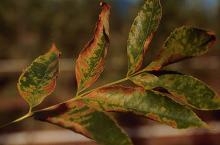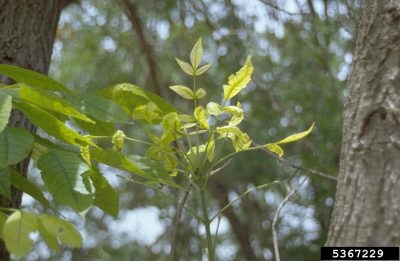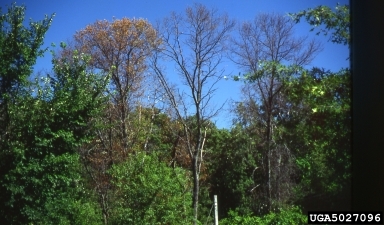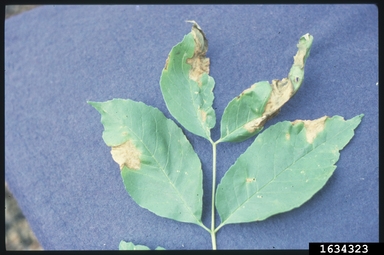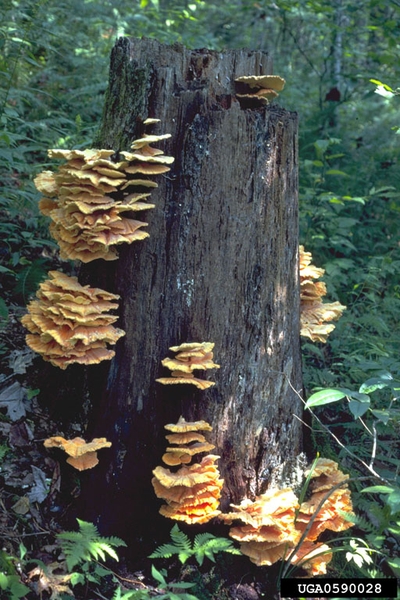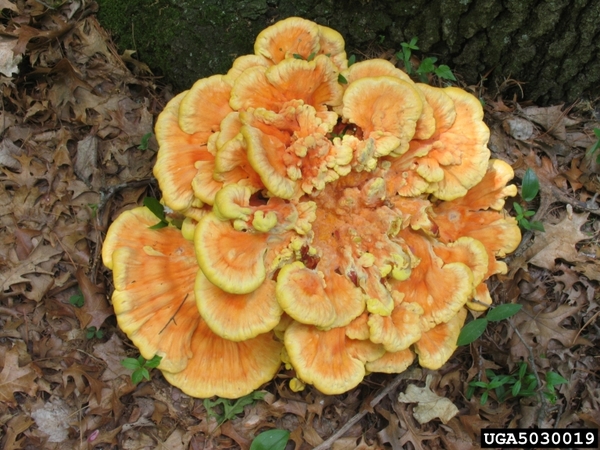Introduction
Prior to the devastation caused by emerald ash borer, ash trees made up 2% of North Carolina's natural forests. They are scattered components of natural areas, with green ash (Fraxinus pennsylvanica) being the most common and found in bottomland forests. While many insect pests can impact ash health, several diseases are known to occur in the state. This fact sheet takes a brief look at some of these issues.
Verticillium Wilt
Verticillium wilt (caused by Verticillium spp.) is a serious fungal disease that affects over 300 species of trees and shrubs across the United States. Maple and ash are the trees most frequently and seriously affected by the pathogen. The Verticillium fungus lives in the soil and infect plants through their roots. It can lay dormant for many years before afflicting the tree. The first symptom of Verticillium wilt is sudden wilting of leaves and branch dieback. In the sapwood directly underneath the bark, there may be green to brown streaking. Unfortunately, Verticillium wilt is incurable and often fatal. Sanitation is essential in stopping the spread of this disease from branch-to-branch or tree-to-tree. Additionally, planting immune or resistant trees will prevent further fatality in soils with the Verticillium fungus. More information about Verticillium wilt is available from University of Wisconsin Extension.
Ash Yellows
Ash yellows (caused by Candidatus fraxini) is a chronic disease that most frequently affects white ash (Fraxinus americana) and green ash (F. pennsylvanica). It is caused by a phytoplasma, a bacteria-like organism that lives in the phloem (nutrient-conducting tissue) of plants. The symptoms vary between highly susceptible and more tolerant plants, but all plants infected with ash yellows usually experience stunted growth and smaller/thinner leaves. Sometimes, infected trees grow branches in abnormal clustered tufts, also called “witches’ brooms”. Highly susceptible trees often die from this disease, while more tolerant trees may live for years with symptoms. Research suggests leafhoppers and other insects spread the bacteria from tree to tree. There is no cure for ash yellows, so it is important to remove infested trees as soon as possible. More information about ash yellows is available from University of Wisconsin Extension.
Anthracnose
Anthracnose is a group of common foliar diseases caused by several fungi; ash anthracnose is caused by Gnomoniella fraxini. Like other antracnose pathogens, it overwinters in diseased leaves on the ground. Spores infect newly growing plant material in early spring and continue to grow as leaves expand. Symptoms include water-soaked or discolored blotches on leaves, leaf curling, and premature leaf drop. In ash, the blotches on the leaves grow from the margin inward. Generally, anthracnose is not a serious issue, but consecutive infection year after year may weaken the tree. Fungi thrive in high-moisture conditions, so this disease is often more prevelanet during wet springs.The most effective management strategy is to clear infected leaves or branches to prevent spores from beginning new infections in the spring. More information about ash anthracnose is available from Iowa State University Extension and Outreach.
Ganoderma Root Rot
Ganoderma root rot (caused by Ganoderma spp.) is a fungal disease that primarily impacts maple, oak, honeylocust, but also ash and other deciduous trees. A conspicuous sign of this disease is red to brown shelf-like fungi that appear each summer and fall, often at the base of the tree. Symptoms include branch dieback/breakage and stuning, yellowing, or wilting foliage. As the name implies, decay spreads into the base and roots of the tree, predispoing the tree to windthrow. This fungus infects open wounds, therefore it is important to maintain tree health by avoiding wounding and using good cultural practices. In some cases, the tree may be removed. More information about Ganoderma root rot is available from the Texas A&M Plant Disease Diagnostic Lab.
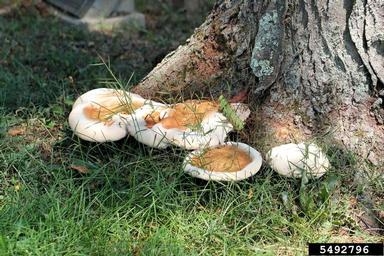
Ganoderma root rot (caused by Ganoderma spp.) is a fungal disease that primarily impacts maple, oak, honeylocust, but also ash and other deciduous trees. A conspicuous sign of this disease is red to brown shelf-like fungi that appear each summer and fall, often at the base of the tree.
Curtis E. Young, The Ohio State University, Bugwood.org.
Laetiporus Root Rot
Laetiporus root rot (also called sulfur fungus rot; caused by Laetiporus sulphureus) is a brown rot on ash, oak, and many other hardwoods. It decays wood, causing loss of structural itnegrity and a poswedery texture. A distinctive sign of this disease is yellow to orange fruiting bodies (mushrooms) occurring in overlapping shelves on the main trunk of the tree. This wood-decay fungus attacks the heartwood, so external symptoms may not be present until the sapwood begins to decay later in the infection cycle. Symptoms may include depressed and cracked bark along with limb dieback and breakage. Fungal members of this species complex is also referred to as "chicken of the woods" because it is a tasty edible mushroom. More information about root and butt rots is available from Iowa State University Extension and Outreach.
References
Ash - Verticillium Wilt. (n.d.). Pacific Northwest Pest Management Handbooks.
Gillman, D. (2011, September). Ash Yellows. UMass Extension Landscape, Nursery, and Urban Forestry Program.
Gleason, M., Sweets, L., & Luley, C. (2006, July). Anthracnose of Shade Trees. Iowa State University Extension and Outreach.
Healy, R. (2011, July 11). Root and butt rots of hardwood trees. Iowa State University Extension and Outreach.
Hudelson, B. (2013, May 5). Verticillium Wilt of Trees and Shrubs. Wisconsin Horticulture Division of Extension.
Le, T. T. (n.d.). Ganoderma Rot. Texas Plant Disease Diagnostic Lab.
Olis, J., & Hudelson, B. (2012, August 6). Ash Yellows. Wisconsin Horticulture Division of Extension.
Moorman, G. W. (2016, July 31). Ash Diseases. PennState Extension.
Publication date: May 16, 2022
N.C. Cooperative Extension prohibits discrimination and harassment regardless of age, color, disability, family and marital status, gender identity, national origin, political beliefs, race, religion, sex (including pregnancy), sexual orientation and veteran status.

